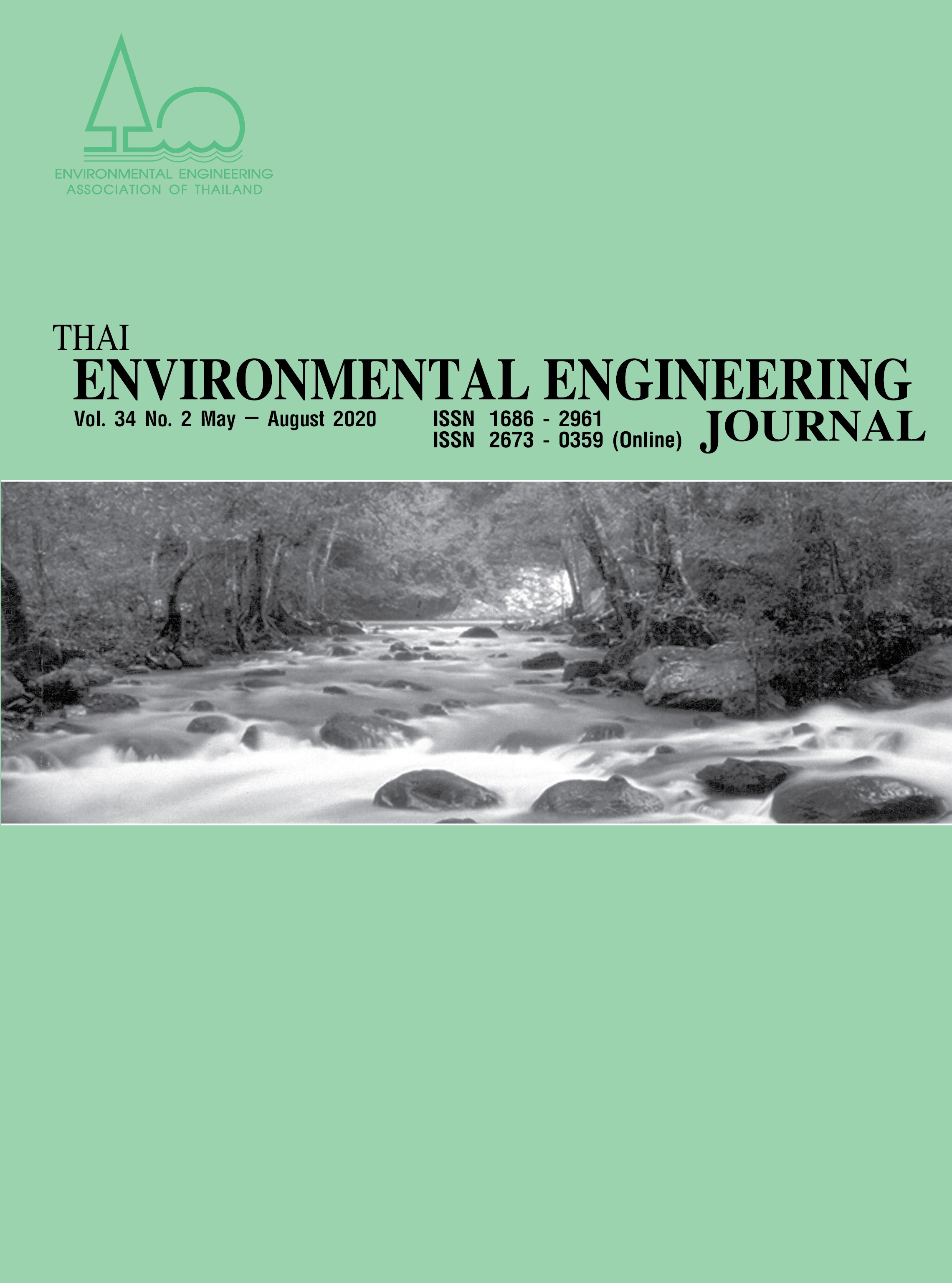Dry Deposition Velocities of Trace Metals in Saraburi, Thailand
Main Article Content
Abstract
Dry deposition is defined as the deposition to land or water of particulate matter. Atmospheric deposition is a major process that removes pollutants from the atmosphere and an important source of nutrients and contaminants for ecosystems. Daily dry deposition flux and Total Suspended Particulates (TSPs) in the atmosphere were measured seasonally at 4 locations in Saraburi, Thailand in 2018.
The TSPs were collected using traditional Hi-Volume Air Sampler. Deposition fluxes were collected using dry deposition plates as introduced by Air Quality Laboratory, Illinois Institute of Technology, IL, U.S.A. Particulate deposited on the deposition plates and the filters from the Hi-Volume Air Sampler were analyzed for 16 trace metals using Digestion, Inductively Coupled Plasma Method. Dry deposition velocities (deposition flux/atmospheric concentration) for trace metals including Pb, Ag, As, Ba, Cd, Cr, Cu, Hg, Mn, Ni, Sb, Se, Sn, Tl, V and Ti were calculated. The results based on 2018 observations found that dry deposition plays a significant role in trace metals deposition in Saraburi, Thailand. The dry deposition velocities of 16 trace metals are 0.038, 0.042, 0.0022, 0.0018, 0.0089, 0.0097, 0.0021, 0.000136, 0.0278, 0.008, 0.0005, 0.000085, 0.000044, 0.763, 0.00153 and 0.0434 respectively
Article Details
References
Davis A.P., Shokouhian M. and Ni S. 2001. Loading estimates of lead, copper, cadmium, and zinc in urban runoff from specific sources. Chemosphere, 44(5): 997-1009.
Van Metre P.C. and Mahler B.J. 2003. The contribution of particles washed from rooftops to contaminant loading to urban streams. Chemosphere, 52(10): 1727-1741.
Zhang L., Fang G.C., Liu C.K., Huang Y.L., Huang J.H. and Huang C.S. 2012. Dry deposition fluxes and deposition velocities of seven trace metal species at five sites in Central Taiwan—a summary of surrogate surface measurements and a comparison with model estimation. Atmos. Chem. Phys., 12, 3405-3417.
Holsen T.M. and Noll K.E. 1992. Dry deposition of atmospheric particles: application of current models to ambient data. Environ. Sci. Technol., 26(9): 1807-1814.
Caffery P.F., Ondov J.M., Zufall M.J. and Davidson, C.I. 1998. Determination of size dependant dry particle deposition velocities with multiple intrinsic tracers. Environ. Sci. Technol., 32(11): 1615-1622.
Stolzenbach K.D., Lu R., Xiong C., Friedlander S., Turco R., Schiff K. and Tiefenthaler L. 2001. "Measuring and Modeling of Atmospheric Deposition on Santa Monica Bay and the Santa Monica Bay Watershed." Report to the Santa Monica Bay Restoration Project.
Paode R.D. and Holsen T.M. 1996. Standard operating procedure for preparation, handling and extraction of dry deposition plates: dry deposition of atmospheric particles. Revision 2.
Tai H.S., Lin J.J. and Noll K.E. 1999. Characterization of atmospheric dry deposited particles at urban and non-urban locations. Journal of Aerosol Science, 30(8): 1057-1068.
Shahin U.M., Yi S.M., Paode R.D. and Holsen T.M. 2000. Long-term elemental dry deposition fluxes measured around lake Michigan with an automated dry deposition sampler. Environmental Science and Technology, 34, 1887-1892.
Dloske D.A. 1995. Deposition of atmospheric pollutants to monuments, statues and buildings. Science of the Total Environment, 167, 15-31.
Simcik M.F., Franz T.P., Zhang H. and Eisenreich S.J. 1998. Gas-particle partitioning of PCBs and PAHs in the Chicago urban and adjacent coastal atmosphere: state of equilibrium. Environmental Science and Technology, 32, 251-257.
Zufall M.J., Davidson C.I., Caffrey P.F. and Ondov J.M. 1998. Airborne concentrations and dry deposition fluxes of particulate species to surrogate surfaces deployed in Southern Lake Michigan. Environmental Science and Technology, 32, 1623-1628.
Sehmel G.A. and Hodgson W.H. 1978. A model for predicting dry deposition of particles and gases to environmental surface, DOE report PNLSA-6721. Pacific Northwest Laboratory, Richland, WA.
Chamberlain A.C. 1953. Aspects of travel and deposition of aerosol and vapour clouds. Atomic Energy Research Establishment, Report AERE-HP/R-1261.
Environmental Engineering Program. Precipitation Chemistry and Atmospheric Deposition of Trace Elements in Northeastern Minnesota. Department of Civil and Mineral Engineering, University of Minnesota, Minneapolis, Minnesota.


